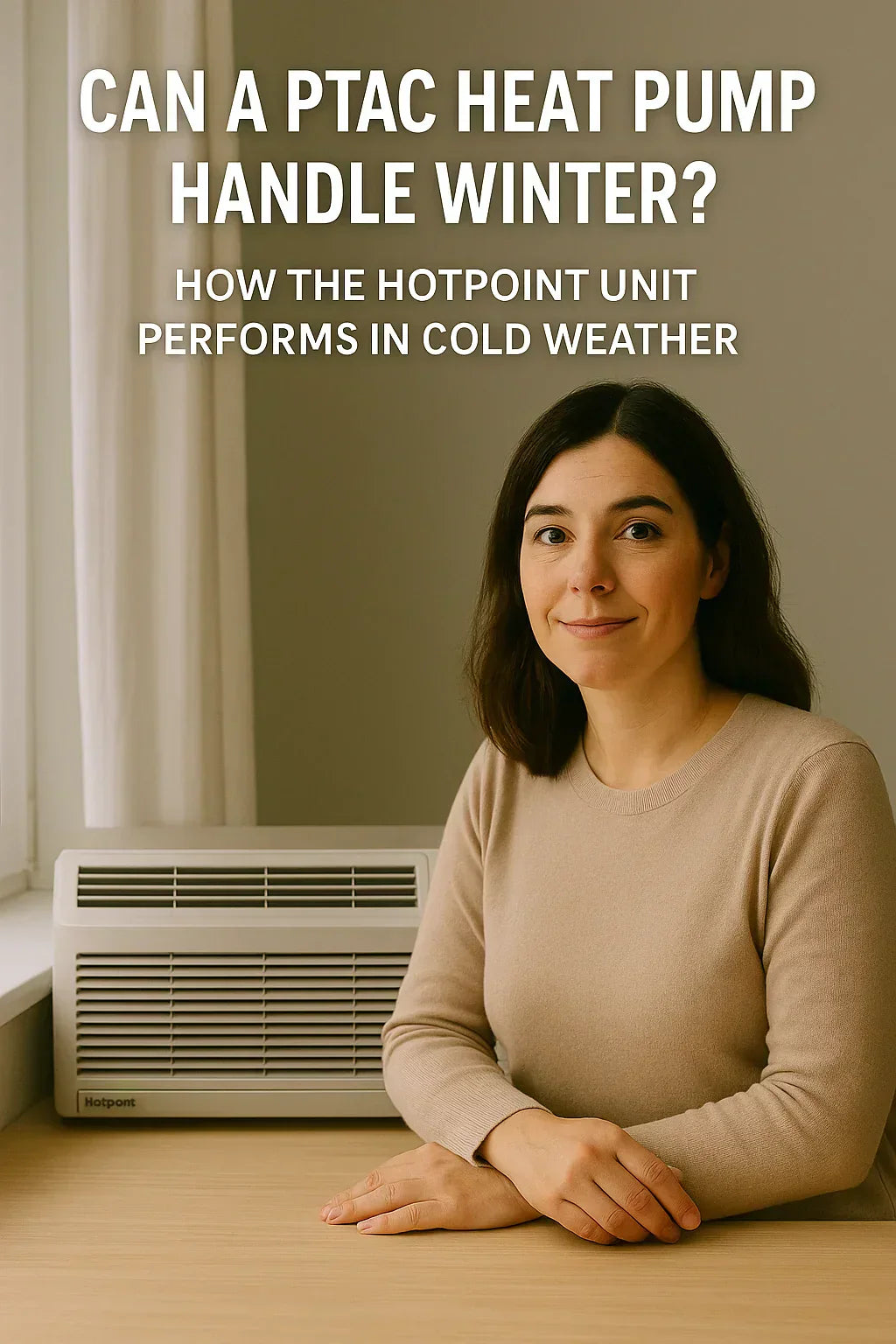As PTAC (Packaged Terminal Air Conditioner) heat pumps become more popular for year-round comfort, one of the most common questions is: Can they really handle winter? If you live in a region where temperatures dip below freezing, it’s critical to know whether a PTAC heat pump is up to the task.
This guide explores how PTAC heat pumps work in cold conditions, how the Hotpoint AHHS07D3XXA 7,000 BTU Heat Pump PTAC with 3.5 kW Heat Kit performs, and when it makes sense to choose a PTAC with both heat pump and electric backup heat—like Savvy did for her Texas home office.
⚡ What Is a PTAC Heat Pump and How Does It Work?
A PTAC heat pump functions like an air conditioner in reverse: it draws heat from the outdoor air and moves it indoors using a refrigerant cycle. It provides highly efficient heating as long as outside temperatures stay within moderate levels.
Key Benefits:,
-
Heats and cools from a single wall unit
-
No ductwork required
-
Efficient and cost-effective for moderate climates
How It Heats:
-
Reverses refrigerant cycle
-
Pulls thermal energy from outside air
-
Transfers it inside using coils and fan
Learn more about PTAC heat pump technology from Energy Star.
🌬️ What Happens When Temperatures Drop?
Heat pump performance decreases as the outside air temperature drops. That’s because there’s less ambient heat to extract.
Typical PTAC Heat Pump Performance:
-
Above 40°F: High efficiency (COP 3.0+)
-
32°F–40°F: Moderate performance (COP ~2.0)
-
Below 30°F: Reduced capacity; may struggle to maintain setpoint
-
Below 25°F: Most units switch to backup heat automatically
This is why many heat pump PTACs include a built-in electric heat kit that takes over when needed.
⚠ Backup Heat: What Is a 3.5 kW Electric Heat Kit?
The Hotpoint AHHS07D3XXA includes a 3.5 kW electric resistance heat kit. This secondary heat source ensures continued warmth when the heat pump can no longer keep up.
How It Works:
-
Thermostat triggers backup heat below a set threshold (~30°F)
-
Electric coils heat the air directly
-
Fan distributes warm air evenly
Benefits:
-
Guarantees reliable heating in any weather
-
Automatic transition—you don’t have to do anything
-
Ideal for locations with occasional cold snaps
This hybrid setup is what makes units like Hotpoint so versatile and winter-ready.
🛍️ Real-World Example: How the Hotpoint Performs
Savvy lives in Dallas, TX, where winter temperatures hover between 25°F and 50°F during the coldest months. She installed the Hotpoint 7,000 BTU PTAC with a heat pump and 3.5 kW backup heat kit in her 280 sq ft office.
Her Findings:
-
Heat pump maintained 70°F comfortably down to 34°F
-
Electric backup heat kicked in automatically at ~29°F
-
Unit kept her room cozy even during a two-day freeze
“I didn’t even realize it had switched to electric heat until I checked the settings—it was seamless,” she noted.
🔬 Manufacturer Specs: Hotpoint Cold Weather Rating
-
Heat Pump Efficiency: ~9.5 EER / ~3.0 COP above 40°F
-
Heating Capacity: 7,000 BTUs + 3.5 kW backup (~11,900 BTUs total)
-
Voltage: 230V, 20A circuit required
-
Thermostat Control: Built-in with auto-switching
🌍 Where Heat Pump PTACs Work Best
Ideal Regions:
-
Southeastern U.S. (e.g., Florida, Georgia, Texas)
-
Southern California
-
Pacific Northwest
Less Ideal (without strong backup heat):
-
Northern Plains
-
New England
-
Rocky Mountain states
Refer to the DOE Climate Zone Map to determine your local needs.
🏡 How to Improve Winter Performance
You can help your PTAC perform better in winter by minimizing heat loss and maximizing efficiency:
Tips:
-
Seal the wall sleeve with weatherproofing foam or caulk
-
Install thermal curtains to insulate windows
-
Close doors to keep heat in the target room
-
Clean the filter monthly for proper airflow
-
Use a ceiling fan in reverse to circulate warm air
These steps reduce heating load and help the heat pump stay in primary mode longer before switching to electric heat.
🔌 Electrical Setup for Winter Use
Heating with electricity requires proper wiring and power supply.
For the Hotpoint 7,000 BTU PTAC:
-
Voltage: 230V
-
Amperage: 20A minimum
-
Plug Type: NEMA 6-20P or direct-wired
Always use a dedicated circuit. Do not share the outlet with other high-draw appliances.
Learn more from UL’s PTAC electrical guide.
💡 Common Questions
❄️ Can I run the PTAC heat pump overnight?
Yes. The thermostat will switch to backup heat if needed. Just set your desired temp and sleep comfortably.
🔥 Will it work during an ice storm?
Yes, as long as power is available. The electric heat kit ensures you won’t be left in the cold.
🌀 Will it dry out the air in winter?
Slightly. Like most forced air systems, you may want a small humidifier if you experience dryness.
✅ Final Verdict: Can a PTAC Heat Pump Handle Winter?
Yes—if you choose the right unit and prepare the space properly.
| Situation | Recommendation |
|---|---|
| Mild to moderate winters (25°F+) | Heat pump PTAC with backup heat |
| Occasional deep freezes | Same (auto-switching heat kit helps) |
| Sub-zero climates (consistently) | Electric-only PTAC or full HVAC system |
The Hotpoint AHHS07D3XXA offers the best of both worlds: efficient heating most of the year and reliable electric heat when things get truly cold.
In the next topic we will know more about: PTAC Energy Efficiency Ratings Explained: EER, CEER & Why They Matter







